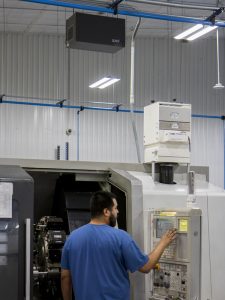
Primary Control Mist Collector mounted on CNC Machine with secondary control mist collector hanging from the ceiling.
Oil mist is created when metal working fluids come in contact with milling or grinding processes and are dispersed into the air. Metalworking fluids are used to reduce friction, providing cooling and prolong the life of tools. Oil mist can become oil smoke when exposed to high temperatures and the oil starts to burn before emitting into the air.
There are two primary types of mist collectors:
Primary Control Mist Collectors – Primary control mist collectors are mounted on the machine and filter contaminates at the source.
Secondary Control Mist Collectors – Secondary control mist collectors hang from the ceiling or can be stand mounted in order to catch additional mist from industrial processes. This type of mist collector is also feasible when direct mounting is not available.
Why Install a Mist Collector?
Employers should install a mist collection system in order to improve employee health and safety, reduce worker lawsuits and liability, and meet government regulations restricting exposure to oil mist. Exposure to oil mist can result in eye and skin irritation, shortness of breath, vomiting, fever, rapid heartbeat, headaches, fatigue and burning sensation in mouth, throat or stomach. Oil mist exposure can also lead to an increased risk of cancer and diseases of the skin and respiratory system.
OSHA (Occupational Safety and Health Administration), NIOSH (National Institute for Occupational Safety and Health) and ACGIH (Association Advancing Occupational and Environmental Health) all restrict the amount of oil mist employees are exposed to. The chart below details each organization’s limit to oil mist exposure. If employers do not follow OSHA guidelines, OSHA can write citations which may result in fines. To determine the air quality in your location, industrial hygienists must be consulted. To find one near you please visit American Industrial Hygiene Association: Find an Industrial Hygienist Website
| OSHA Permissible Exposure Limit | 5 mg/m3 over 8 hr/day, 40 hrs/wk [OSHA, Table Z-1, 9/6/12] |
| NIOSH Recommended Exposure Limit | 5 mg/m3 at 10 hr/day, 40 hrs/wk 10 mg/m3 ST – 15 minute period [NIOSH Pocket Guide to Chemical Hazards, p 237, 7/7/16] |
| ACGIH Threshold Limit Values | 5 mg/m3 over 8 hr/day, 40 hrs/wk [TLV and BEI Book, 7th Ed, 2018] |
How do mist collectors work?
Primary Control Mist Collectors
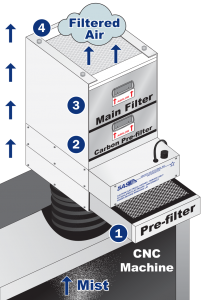 – Step 1 –
– Step 1 –
Pre-filter – Mist enters mist pre-filter. Depending on the application, collected oil, coolant or water drains back into the machinery to be reused.
– Step 2 –
Carbon Pre-filter – Air is filtered through a carbon pre-filter where large particulates are captured.
– Step 3 –
Main Filter- Air is purified by passing through a final filter. This final stage will capture fine particulates. Filter choices include:
• ASHRAE Filter (up to 95% efficiency on particles down to 0.5 microns)
• HEPA Filter (up to 99.97% efficiency on particles down to 0.3 microns)
• ULPA Filter (up to 99.9995% efficiency on particles down to 0.12 microns)
– Step 4 –
Filtered Air – Filtered air is discharged back into work area.
Secondary Mist Collectors
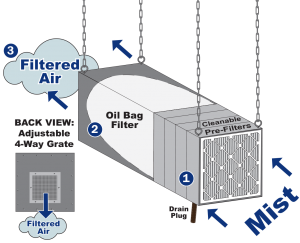 – Step 1 –
– Step 1 –
4 Cleanable Mesh Pre-filters – Mist enters the system and is filtered through a set of 4 cleanable mesh pre-filters.
– Step 2 –
Oil Bag Filter – Any remaining oil and fi ne particulates are then filtered out of the air with the oil bag filter and drained into the drain plug to allow collection of oil for repurpose.
– Step 3 –
Filtered Air – Filtered Air is released back into the workspace through an adjustable four-way grate.
Sentry Air Mist Collector Systems
Primary Control Mist Collectors
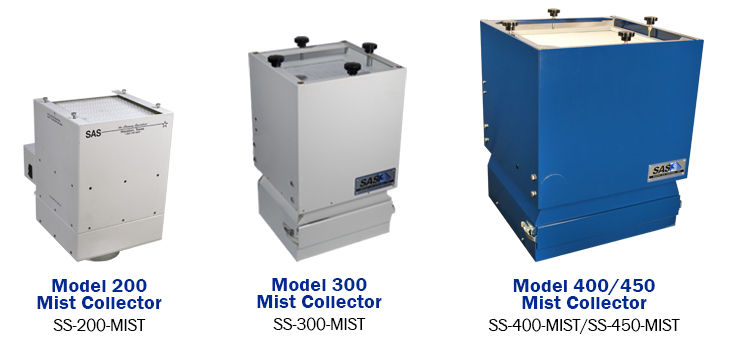
The primary control mist collectors (Models 200, 300, 400, and 450) offer a compact and powerful solution to filter oil mist, water mist or coolant mist produced from industrial processes. This line of units mounts to the machinery to capture the oil from the source. Commonly these units are used for CNC mist elimination but can also be used for air filtration on other machines that produce oil, water or coolant mist. These unique and simple units provide ease of installation due to no external exhaust or ducting is required for air output. The source capture mist collectors features quiet operation, energy efficiency and minimal maintenance.
The primary control mist collectors filter the air through a three filter system: cleanable mist pre-filter, carbon pre-filter and main filter with customizable options. The unique washable mist pre-filter collects mist and drains the oil back into the system for repurposing, depending on the application. The carbon pre-filter adsorbs chemicals eliminating fumes and smells. The main filter is available in ASHRAE, HEPA, or ULPA filter.
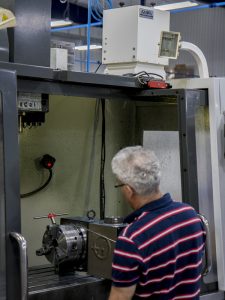 Key Features:
Key Features:
• Washable mist pre-filter
• Reliable, low maintenance system
• Quiet operation
• Low power consumption
• Small footprint
• Long filter life
• Portable and lightweight (Models 200 & 300 only)
• Simple, quick, “no tool” filter change
• Main filter media made of all flame retardant materials
Applications:
• CNC machines oil mist
• Metal processing coolants
• Synthetic fiber processing oils
• Parts washer exhaust
Secondary Control Mist Collectors
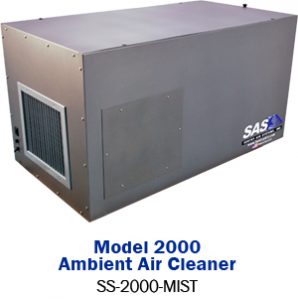 The secondary control mist collectors (Model 2000) are designed to capture and collect excess mist commonly found in machining and tooling shops. Typical applications include general shop mist collection, open CNC lathes and waterjet machines that produce ambient mist, and other applications that produce oil mist, water mist or coolant mist.
The secondary control mist collectors (Model 2000) are designed to capture and collect excess mist commonly found in machining and tooling shops. Typical applications include general shop mist collection, open CNC lathes and waterjet machines that produce ambient mist, and other applications that produce oil mist, water mist or coolant mist.
This system is commonly used in conjunction with the source capture mist collectors but can be utilized as the primary filtration unit as well. In particular, these units are ideal for situations where direct mounting is not available or feasible.
The secondary control mist collectors use a five filter process that was designed to handle mist and other wet environments. This filtration process consists of four cleanable mesh pre-filters and one oil bag filter. Collected oil from the filters is drained into an oil drain plug to be repurposed.
This unit can be installed by hanging from the ceiling, mounting to a fume extractor stand, placing on a cart or table, or mounting to a wall shelf. For large areas, multiple ambient air mist collectors are recommended to increase efficiency and create an optimal airflow pattern.
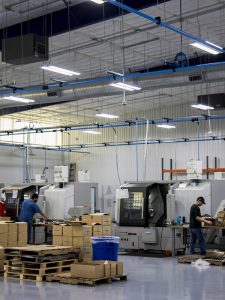
Key Features:
• Washable mist filter
• Reliable, low maintenance system
• Quiet operation
• Sturdy construction
• Long filter life
• Simple, quick, “no tool” filter change
• Oil drain plug to collect oil for repurposing
• Four way adjustable grate air exit pathway
• Main filter media made of all flame retardant materials
Applications:
• Ambient air mist collection
• Open CNC lathes
• Waterjet machines
Contact us today to help you choose the best suited solution to control oil mist and other mists in CNC machine shops.
Feel free to give us a call — 1-800-799-4609

 Made in the USA
Made in the USA